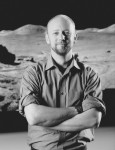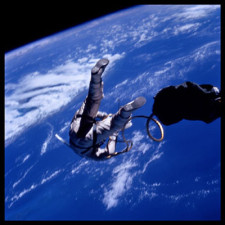
Michael Light
American, 1963-
Southern Lunar Hemisphere, Homebound, Photographed by Alfred Worden, Apollo 15, July 26 August 7, 1971, 1999 (printed 2003)
chromogenic print, edition 18/25
48 3/4 × 85 5/8 in.
SBMA, Museum purchase with funds provided by PhotoFutures
2004.14

Undated photo of Michael Light

Edward White in the first American spacewalk, Gemini 4, 1965, also in SBMA collection.
COMMENTS
FULL MOON was published in eight international editions in 1999, and concurrently exhibited at the San Francisco Museum of Modern Art and the Hayward Gallery, London. From there it traveled the world, and much of the exhibition found a permanent home in 2000 at the Rose Center For Earth and Space at the American Museum of Natural History in New York, where it may be seen to this day. Hundreds of thousands of copies have been printed. FULL MOON offers a single composite journey to the Moon and back comprised of imagery from the 9 actual Apollo missions, along with Earth orbital imagery from the Gemini missions. One of the primary goals of the project was to think about the some 33,000 Apollo images in terms of the traditions and meanings of landscape representation, rather than science, cold-war politics, and exploration alone. An edition of c-prints was released in 1999, and over the years the book, museum exhibition, and print edition have come to be seen as a standard benchmark, art-world and otherwise, for inflight NASA Apollo photographic material.
michaellight.net
From 1963 – 1972 NASA’s Apollo program landed six missions on the moon and yielded a wealth of scientific data as well as 32,000 photographs. From 1995-2000, photographer Michael Light worked with NASA’s archives to revisit and reexamine these photographs. Light’s project culminated in a book and museum exhibition entitled FULL MOON. The book was published in six languages in 1999 (the American by Knopf, New York), and the museum exhibition opened concurrently that summer at London’s Hayward Gallery and the San Francisco Museum of Modern Art. The photographs from that show are now on permanent display at the American Museum of Natural History’s Rose Center for Earth and Space in Manhattan. In the years since, FULL MOON has come to be considered the definitive visual statement on the Apollo photographic archive.
As a landscape photographer Michael Light is not only interested in the physical aspects of a place but also spaces where humans seem dwarfed by their natural surroundings, places where they confront powerful natural forces. To him the Moon was perfect subject. For FULL MOON, Light chose 129 of the 32,000 images from NASA’s archives and wove them into a narrative that begins with launch and is followed by a walk in space, an orbit of the Moon, lunar landing and exploration, and a return to Earth. He focused on images that had not been seen before and timed to create the effect of the viewer being in space by including views looking out the spacecrafts’ windows and close-ups of the astronauts. He also shows us the sublime grandeur of the Moon itself. Close-up images show its surface details and textures while images shot from above reveal its vastness and mass. Light’s selection and arrangement of these images lead the viewer on a thrilling journey to the Moon, and his project is imbued with the same sense of adventure and discovery inherent in the Apollo missions themselves.
The photographs in the exhibition are all made using latest in direct-digital photographic printing processes from Light’s drum scans of NASA masters. Light scanned at beyond-film grain resolution to capture every bit of information in the masters, and together with the subtlety allowed by digital image processing, these prints offer unprecedented clarity, scale and precision. There is nothing like them available through any channel, including NASA.
Michael Light received his B.A from Amherst College and his M.F.A in photography from the San Francisco Art Institute. His photographs are in the collections of the San Francisco Museum of Modern Art, The Getty Research Library, the Los Angeles County Museum of Art, the Center for Creative Photography, Tucson, AZ and the Museum of Photographic Arts, San Diego, CA among others. In 2007 he received a John Simon Memorial Foundation Guggenheim Fellowship for Photography. He currently lives and works in San Francisco, CA.
https://www.josephbellows.com/exhibitions/michael-light
SBMA CURATORIAL LABELS
Through experimentation with aerial photography early in his career, Michael Light became interested in what he considers “the ultimate landscape photography” that was produced during the Apollo program. As part of his Full Moon series, Light scanned and digitally enhanced photographic negatives found in the NASA archive to create stunningly sharp images of outer space. This image, taken by astronaut Alfred Worden shortly after Apollo 15 began its journey back to Earth, presents a sweeping panorama of the southern hemisphere of the moon in which the lunar landscape reads as a sublime desert amid an otherwise lightless void.
- The Observable Universe: Visualizing the Cosmos in Art, 2019
Contemporary photographer Michael Light’s Full Moon series is a result of the artist’s prolonged investigation of the extraterrestrial landscape. Having witnessed the Apollo space missions as a young child between 1967 and 1972, Light was intrigued by the thrilling allure of astronaut adventure and discovery. Twenty five years later, Light’s interests in exploration and the topography of the untouched and largely unknown led to his appropriation and reinterpretation of lunar photographs taken by Apollo astronauts. He writes, “I wanted to be an extraterrestrial photographer.”
In search of photographs beyond the iconic images of the Apollo missions, Light spent four years researching the Apollo inflight photographic archive housed in Houston, Texas. Selecting from over 33,000 Apollo images, Light’s Full Moon series includes just over 120 photographs. According to Light, the lunar photographs are most captivating for the moon is the only celestial body humans have travelled to and photographed in person.
- Ridley-Tree Gallery, 2016
